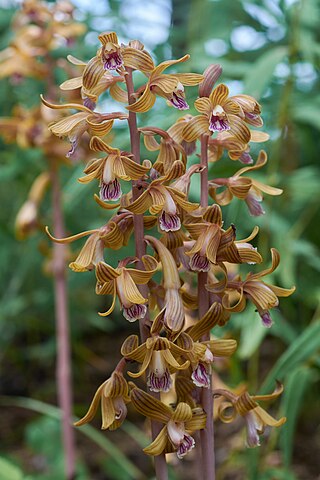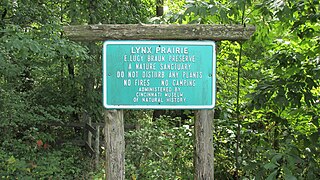
Hesperocyparis arizonica, the Arizona cypress, is a North American species of tree in the cypress family Cupressaceae, native to the southwestern United States and Mexico. Populations may be scattered rather than in large, dense stands.

Hexalectris is a genus of the family Orchidaceae, comprising 10 known species of fully myco-heterotrophic orchids. These species are found in North America, with the center of diversity in northern Mexico. None of the species are particularly common. Hexalectris spicata has a wide distribution and is likely the most abundant member of the genus, but is nevertheless infrequent throughout its range. Other species are rare, and some, such as H. colemanii, are threatened or endangered. All species that have been studied form associations with ectomycorrhizal fungi that are likely linked to surrounding trees. Many Hexalectris species are found in association with oak trees (Quercus), which are ectomycorrhizal.

Cypripedium acaule, the pink lady's slipper or moccasin flower, is a species of flowering plant in the orchid family Orchidaceae native to eastern North America. It is currently the provincial flower of Prince Edward Island, Canada, and the state wildflower of New Hampshire, United States.

Calopogon tuberosus, the tuberous grass pink, is an orchid native to eastern North America.
Coralroot is a common name for several plants which may refer to:

Corallorhiza trifida, commonly known as early coralroot, northern coralroot, or yellow coralroot, is a coralroot orchid native to North America and Eurasia, with a circumboreal distribution. The species has been reported from the United States, Canada, Russia, China, Japan, Korea, India, Nepal, Kashmir, Pakistan, and almost every country in Europe.

Corallorhiza mertensiana, or Pacific coralroot, is a coralroot orchid native to the shady conifer forests of northwestern North America. It also goes by the common names Western coralroot and Mertens' coralroot. Corallorhiza mertensiana was previously considered a subspecies of Corallorhiza maculata but was given species rank in 1997 by Freudenstein.

Quercus arizonica, the Arizona white oak, is a North American tree species in the beech family. It is found in Arizona, New Mexico, western Texas, Sonora, Chihuahua, Coahuila, Sinaloa, and Durango.

Lynx Prairie is a 52-acre (210,000 m2) nature preserve located in Adams County, Ohio, United States, near the community of Lynx. The preserve features a group of cedar glades which harbor rare prairie species, surrounded by forests on all sides.

Eulophia ecristata, synonym Orthochilus ecristatus, or giant orchid, is a terrestrial species of orchid native to Cuba and to the southeastern United States. In 2014, it was proposed that the species should be transferred to the genus Orthochilus, but as of December 2023 this was not accepted by Plants of the World Online. This is one of several species known as a "giant orchid".

Hexalectris arizonica, the spiked crested coralroot or Arizona crested coralroot, is a terrestrial, myco-heterotrophic orchid lacking chlorophyll and subsisting entirely on nutrients obtained from mycorrhizal fungi in the soil. It is native to Arizona, New Mexico, Texas and Coahuila. It is closely related to H. spicata and sometimes regarded as a variety of that species.
Hexalectris grandiflora, the largeflower crested coralroot or giant coral-root, is a species of orchid native to Mexico from Chihuahua south to Oaxaca, as well as to western and north-central Texas. It is a myco-heterotrophic species, lacking chlorophyll and subsisting entirely on nutrients obtained by fungi in the soil.
Hexalectris colemanii, or Coleman's crested coralroot, is a terrestrial, myco-heterotrophic orchid lacking chlorophyll and subsisting entirely on nutrients obtained from mycorrhizal fungi in the soil. It is a very rare species endemic to southern Arizona, known from only three counties. It is closely related to H. revoluta and the two are sometimes considered varieties of the same species.
Hexalectris revoluta, the Chisos Mountain crested coralroot, is a terrestrial, myco-heterotrophic orchid lacking chlorophyll and subsisting entirely on nutrients obtained from mycorrhizal fungi in the soil. It is closely related to H. colemanii; the two are regarded by some authors as varieties of the same species. Hexalectris revoluta is native to western Texas, southeastern New Mexico and Chihuahua.

Liparis liliifolia, known as the brown widelip orchid, lily-leaved twayblade, large twayblade, and mauve sleekwort, is a species of orchid native to eastern Canada and the eastern United States. It can be found in a variety of habitats, such as forests, shrublands, thickets, woodlands, and mountains. The orchid is considered globally secure, but it is considered rare or endangered in many northeastern states.

Urochloa fusca, the browntop signalgrass, is a wild grass species with a native range extending from Paraguay in South America to the southern United States, and it is now found as a weed in Australia. The species is diploid, with a base chromosome number of 9, and utilizes the PCK enzymatic subtype of C4 photosynthesis. Based on a molecular phylogeny of the genus Urochloa, the closest relatives of U. fusca are Urochloa arizonica and Urochloa mollis The genome of U. fusca is currently being sequenced by the Joint Genome Institute.
Gaillardia arizonica, the Arizonia blanketflower, is a species of flowering plant in the sunflower family. It is native to northwestern Mexico (Sonora) and the southwestern United States.
Grindelia arizonica, the Arizona gumweed, is a North American species of flowering plants in the family Asteraceae. It is native to the southwestern United States and northern Mexico, in the States of Coahuila, Chihuahua, Arizona, New Mexico, Utah, Texas, and Colorado.

Hexalectris warnockii, the Texas crested coralroot, Texas purple-spike, is a myco-heterotrophic orchid found in the states of Texas and Arizona in the southwestern United States, and in the states of Coahuila and Baja California Sur in northern Mexico. Being myco-heterotrophic, H. warnockii derives all of its nutrients from mycorrhizal fungi.
Schiedeella arizonica is a species of Orchid native to the Southewestern United States, and Mexico. It was first described by Paul Martin Brown in 2000. This species additionally goes by several common names including fallen ladies tresses, parasitic lady's tresses, and Indian-braids.













